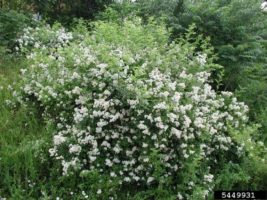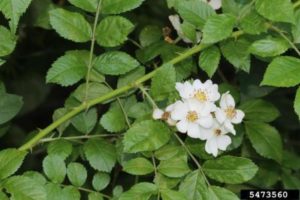

By Kevin Knavish
Environmental and Plant Biology Student interning at the Wayne National Forest
Rosa Multiflora, the Multiflora Rose, is an invasive perennial shrub native to Korea, Japan, and China.
The plant was introduced to the United States in the 1860s to be bread as an ornamental plant. During the 1930s, Multiflora rose was planted to combat erosion in the Midwest and Northeastern States. It was also used to enhance wildlife habitats and to create barriers from animals. By the 1960s the threat of the invasive plant was identified by some conservationists, but the plant continued to be planted by many state governments. Highway departments also planted the rose to limit glare that drivers experience.
Multiflora rose is a climbing and rambling shrub with one or more stems. It can grow in dense thickets quickly and can reach heights up to 15 or 20 feet tall. The leaves are opposite and compound, and the serrate leaflets are ovular with pointed, or acute, tips. The shrub has white flowers that become red berries, as well as sharp prickles that curve toward the base of the stem.
An individual plant may produce up to 500,000 seeds per year, which can stay in the soil bank up to 10 or 20 years. The flowers are monoecious, containing both male and female parts. This allows a single plant to create seeds that can be effectively dispersed by birds and mammals consuming and carrying the fruits, or from falling near the parent. Furthermore, multiflora rose can reproduce vegetatively; if a stem or branch is removed from the plant, the separated limb can sprout new roots.
Multiflora leaves emerge early in the spring, before many other plants, giving it an advantage to utilize light to grow and reproduce earlier than other plants. The rose is also shade-tolerant, but can still dominate sunny areas. Multiflora rose has no predators, but can be combatted by naturalists with herbicide.
Work Cited
Wenning, Bruce. “Multiflora Rose: An Exotic Invasive Plant Fact Sheet – Ecological Landscape Alliance.” Advocating Responsible Stewardship of Land and Natural Resources, 16 July 2012, www.ecolandscaping.org/07/invasive-plants/multiflora-rose-an-exotic-invasive-plant-fact-sheet/.
“Multiflora Rose.” University of Connecticut, https://cipwg.uconn.edu/multiflora-rose/
Leslie J. Mehrhoff. “Multiflora rose plants in bloom.” Marryland Department of Agriculture, University of Conneticut, http://www.mda.state.mn.us/plants/pestmanagement/weedcontrol/noxiouslist/multiflorarose.aspx















Comments